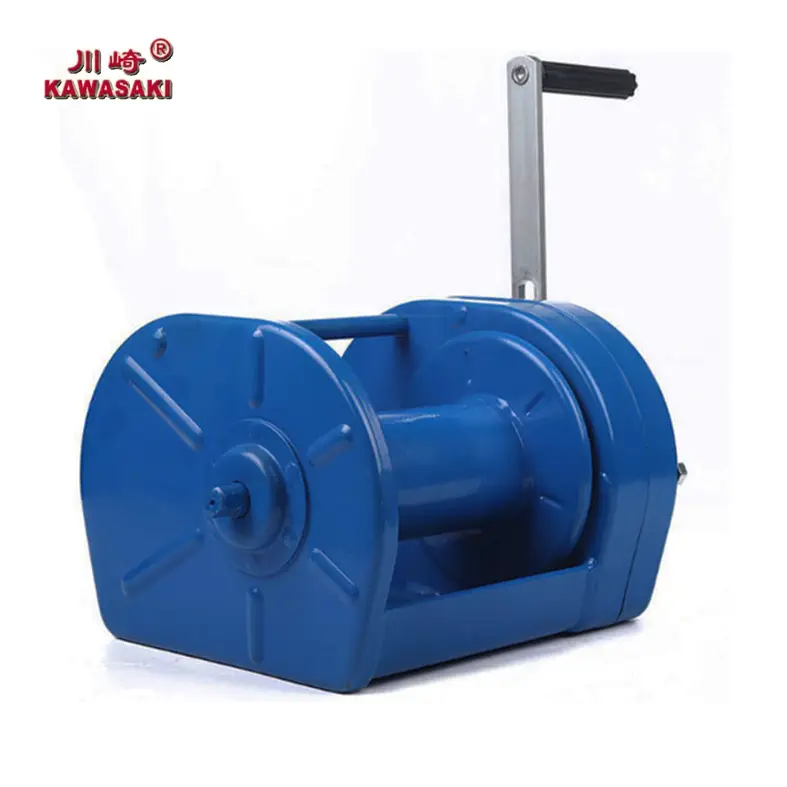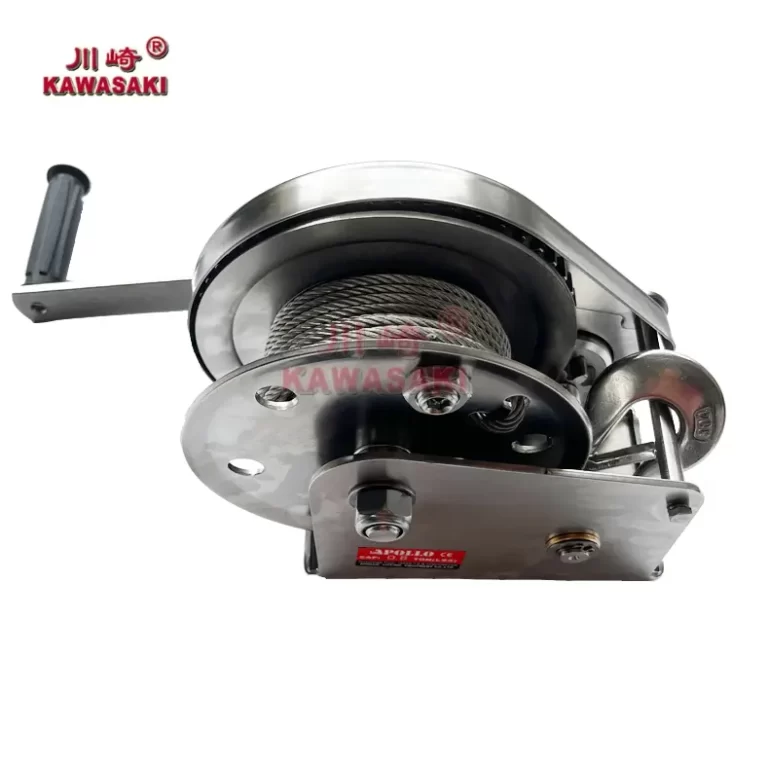When it comes to pulling or lifting heavy loads, every bit of power counts. A winch is already a strong mechanical tool, but when combined with a snatch block, its pulling capacity can surprise even experienced operators. Many people in construction, workshop, and marine industries often ask the same thing — how much weight can a winch really pull when you use a snatch block?
Let’s break it down step by step, looking not only at the mechanics behind winching but also at how Apollo’s KAWASAKI Hand Winch GPW and KAWASAKI Hand Winch JC-E make the most of that extra pulling advantage.
What Does Winch Pulling Power Really Mean
Before figuring out how to double a winch’s power, it’s worth understanding what “pulling power” actually refers to.
Rated Capacity and Real-World Load
Every winch has a rated line pull — the maximum weight it can pull safely on the first layer of the rope. However, that number often changes in real working conditions. Friction, rope angle, slope, and load resistance can all reduce actual pulling strength. For instance, dragging a load across rough ground takes more power than pulling it across a smooth surface.
The Role of Gear Ratio and Drum Diameter
A winch’s gear ratio determines how torque converts into pulling force. A higher ratio provides more pulling strength but moves the load more slowly. The diameter of the drum also affects tension — smaller drums generate more torque, while larger ones reel in faster. Apollo’s KAWASAKI GPW Hand Winch uses precision gears and a robust handle mechanism that provide smooth, consistent torque even under load.
Factors That Limit Pulling Power
Several external factors influence pulling capacity: rope tension, drum alignment, cable layering, and weather conditions. Dust, moisture, or improper spooling can all reduce effective power. That’s why Apollo’s hand winches use a sealed gearbox to prevent debris from affecting the braking and gear system — keeping performance steady even in harsh environments.
How Does a Snatch Block Double the Pulling Power
At first glance, a snatch block looks simple — just a pulley with a side plate that opens. But inside that simple design lies a clever principle of mechanical advantage.
Mechanical Advantage and Force Distribution
When a winch line passes through a snatch block and returns to the anchor point, the load’s weight is divided between two lines. This effectively doubles the pulling force while reducing strain on the winch motor or handle. For example, a 1-ton winch can pull nearly 2 tons with proper use of a snatch block.
Single Line vs Double Line Configuration
A single-line setup connects the winch directly to the load — simple, but limited in capacity. A double-line setup, using a snatch block, changes everything. By redirecting the rope through the pulley, operators get double strength at half the line speed, which is ideal for heavier, more controlled lifting or dragging.
Common Misconceptions About Doubling Power
It’s a myth that every snatch block setup instantly doubles pulling capacity. The actual gain depends on the angle, friction in the pulley, and the winch’s base strength. Apollo’s engineers design their winches with safety margins that account for real-world use, so operators can achieve consistent performance without pushing mechanical limits.
Which Type of Winch Works Best With Snatch Blocks
Different winches react differently to snatch blocks depending on their design and purpose.
Manual Winch Advantages for Controlled Lifting
Manual winches, like the KAWASAKI HAND WINCH GPW, are ideal for operations where precision and control matter more than speed. The GPW model features a lever handle that allows continuous or swing operation even in tight spaces. It’s especially suitable for jobs that need smooth, gradual pulling — perfect for construction sites, workshops, and confined work areas.
Electric Winch for Continuous Heavy Pulling
Electric winches are built for long, repetitive tasks — like industrial assembly lines or ship maintenance. They pull faster but require more care in load calculation, as electric torque can overstrain cables if not balanced. Apollo also offers electric winch solutions for users needing more consistent, powered lifting over distance.
Matching Snatch Blocks With Load Type
For horizontal dragging, a standard snatch block works well to reduce strain. For vertical lifting, it’s better to use a rated block designed for that purpose. Apollo’s full product line includes pulley blocks and lifting clamps that are tested under ISO9001 standards, offering reliable compatibility with its winch systems.
What Makes Apollo’s Hand Winches Stand Out
Apollo’s commitment to durability and craftsmanship runs deep in every product line.
Precision Engineering and Sealed Gearbox Design
Both the GPW and JC-E models feature sealed gearboxes, protecting internal components from dust and foreign particles — a critical advantage in outdoor or factory environments. This design extends service life and minimizes maintenance interruptions.
Adjustable Handle and Safety Brake System
The adjustable handle lets operators vary the length for optimal torque, while the automatic brake mechanism holds loads firmly during pauses. These thoughtful features make Apollo winches dependable tools for complex lifting tasks.

Certified Quality and Global OEM Service
Every Apollo winch carries international certifications including ISO and CE. The company also provides OEM customization, from voltage settings to color and packaging, allowing distributors and industrial clients to build private-label products backed by Apollo’s proven engineering.
How to Use a Snatch Block Safely With Apollo Winches
A snatch block setup only works if safety comes first.
Step-By-Step Setup Guide
Attach the winch securely to an anchor point. Open the snatch block side plate, feed the wire rope through, and lock it back in place. Hook the block to the load or anchor ring and slowly tension the line before pulling.
Load Monitoring and Angle Control
Keep the pulling angle as straight as possible — side loads can twist the cable or reduce efficiency. Use Apollo’s G80 lifting chain or polyester webbing slings for added stability in complex setups.
Maintenance and Inspection Routine
After each use, check for wire kinks, gear wear, and brake responsiveness. A bit of lubrication on moving parts keeps the snatch block spinning freely, extending both cable and pulley lifespan.
Where Can Apollo Winches Be Used
Apollo’s hand winches are designed for flexibility across industries.
Construction and Workshop Applications
Ideal for lifting beams, positioning machinery, or handling materials where power tools aren’t available.
Marine and Outdoor Recovery Use
Thanks to their corrosion-resistant coatings, both GPW and JC-E perform reliably in coastal or outdoor conditions where moisture is unavoidable.
Agricultural and Utility Operations
Farm maintenance, fencing work, and mechanical repairs all benefit from a solid hand winch setup — especially when combined with a snatch block for that extra pull.
FAQ
Q1: Does a snatch block always double a winch’s pulling power?
A: Not exactly. It can nearly double pulling capacity, but friction, rope condition, and angle can slightly reduce the gain.
Q2: Can Apollo’s hand winches be customized for specific projects?
A: Yes. Apollo offers OEM customization for color, branding, voltage, and even material specifications, depending on project requirements.
Q3: What maintenance does a hand winch need after frequent use?
A: Inspect cables, gears, and brakes regularly. Clean debris from the gearbox area and apply lubricant to keep movement smooth and safe.


